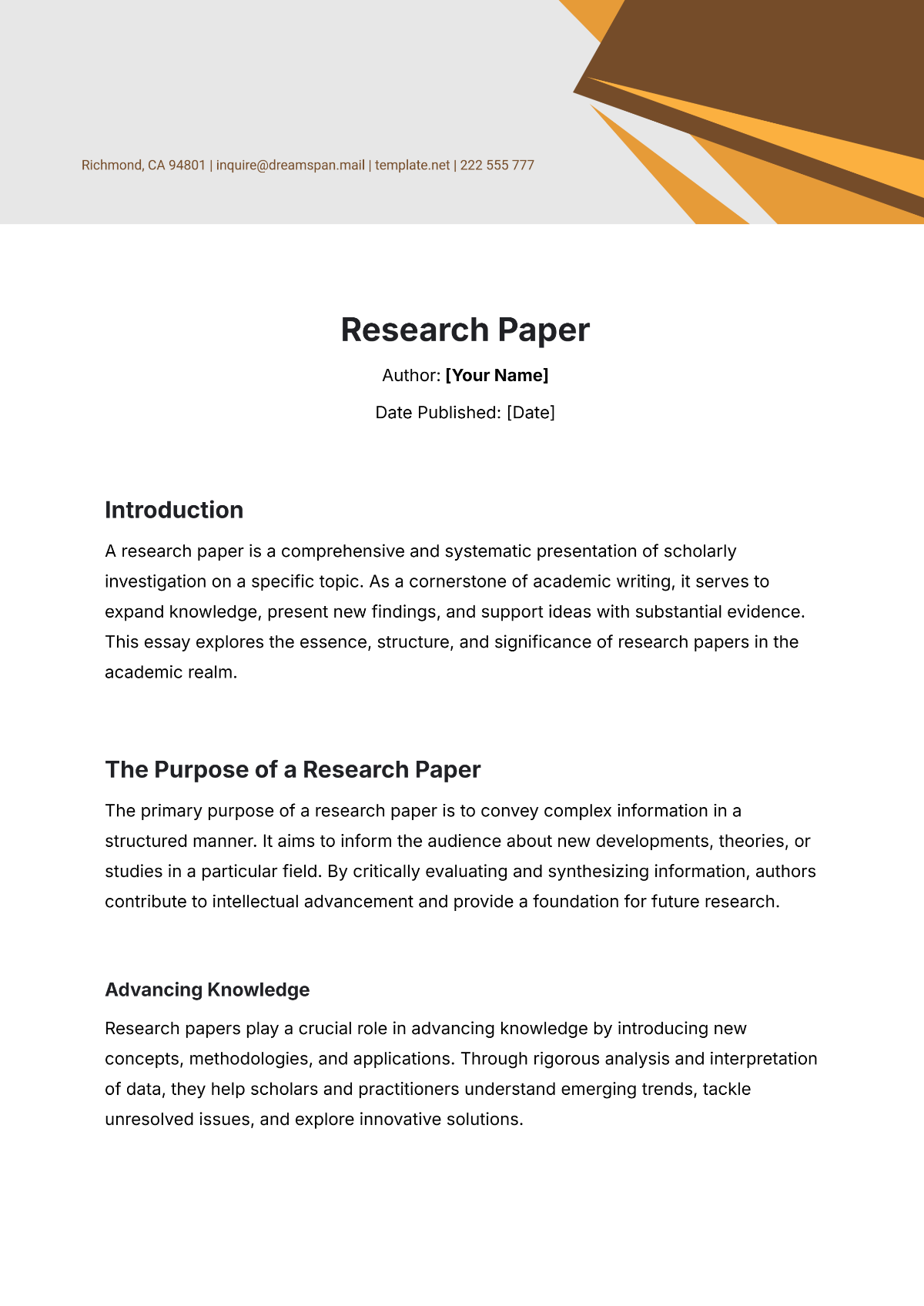Semiotics Paper Chapter Outline
Prepared by: [Your Name]
Date: [Date]
I. Introduction
I.I Overview of Semiotics
Semiotics is the study of signs and symbols and their use or interpretation. It encompasses how meanings are created and communicated. At its core, semiotics explores how anything (a word, an image, a gesture, an object) can function as a sign to convey meaning. This field of study is crucial for understanding the mechanisms of communication, culture, and cognition, as it provides tools to decode the underlying structures of meaning-making in various contexts.
I.II Purpose of the Paper
The primary aim of this paper is to investigate the principles and applications of semiotic theory. By delving into both classical and contemporary theories, this study seeks to uncover how signs and symbols function within different frameworks and contexts. The objectives include elucidating foundational semiotic theories, applying these theories to analyze specific signs and symbols, and contributing to ongoing discussions in the field.
I.III Scope
This paper focuses on analyzing specific signs and symbols within cultural texts, advertisements, and everyday communication. It will examine both visual and textual signs, exploring their denotative and connotative meanings. Key symbols from popular culture, media, and historical artifacts will be analyzed to demonstrate the application of semiotic theory.
I.IV Structure of the Paper
Theoretical Framework: An in-depth exploration of foundational and modern semiotic theories.
Literature Review: Historical development, major contributors, current debates, and research gaps.
Methodology: The approach and techniques used to collect and analyze data.
Case Studies/Analysis: Detailed analyses of selected signs and symbols.
Discussion: Interpretation of findings, implications, limitations, and suggestions for future research.
Conclusion: Summary of key points and final reflections.
II. Theoretical Framework
II.I Foundational Theories
Ferdinand de Saussure's Dyadic Model:
Saussure's model posits that a sign is composed of two parts: the "signifier" (the form of the sign) and the "signified" (the concept it represents). This dyadic model emphasizes the arbitrary relationship between the signifier and the signified, which means that there is no inherent connection between them. Saussure's work laid the groundwork for structuralism and has influenced numerous fields, including linguistics, anthropology, and cultural studies.
II.II Charles Peirce's Triadic Model
Peirce expanded on Saussure's ideas by introducing a triadic model, which includes the "representamen" (the form of the sign), the "object" (what the sign refers to), and the "interpretant" (the understanding of the sign). Peirce categorized signs into three types: icons (resemble their objects), indexes (directly connected to their objects), and symbols (arbitrarily or conventionally related to their objects). This model offers a more comprehensive framework for understanding how signs function in different contexts.
II.III Roland Barthes' Mythologies
Barthes introduced the concept of myth as a second-order semiotic system, where the denotative meaning of a sign becomes the signifier for a connotative meaning. In his work "Mythologies," Barthes explored how cultural myths are constructed and perpetuated through media and everyday objects. His analysis of popular culture has significantly influenced semiotic studies, particularly in understanding how ideology is embedded in everyday life.
II.IV Modern Approaches
Contemporary semiotic theories build upon and extend the foundational frameworks. These include cognitive semiotics, which integrate insights from cognitive science to explore how signs are processed in the mind, and social semiotics, which examine how signs function within social contexts and power structures. Additionally, multimodal semiotics analyzes how meaning is constructed through multiple modes of communication, such as text, image, sound, and gesture.
III. Key Concepts
III.I Signifier and Signified
The "signifier" is the physical form of the sign (e.g., a word, image, sound), while the "signified" is the concept it represents. Understanding the relationship between these two components is fundamental to semiotic analysis.
III.II Denotation and Connotation
Denotation refers to the literal, dictionary definition of a sign, whereas connotation encompasses the cultural and emotional associations attached to it. Analyzing both levels of meaning reveals the deeper layers of interpretation that a sign can evoke.
III.III Icon, Index, and Symbol
Icon: A sign that resembles its object (e.g., a photograph of a tree).
Index: A sign that has a direct connection to its object (e.g., smoke indicating fire).
Symbol: A sign that is arbitrarily linked to its object through cultural conventions (e.g., the word "tree").
IV. Literature Review
IV.I Historical Development
The field of semiotics has evolved through key texts and contributions from various scholars. Beginning with Saussure's "Course in General Linguistics" and Peirce's extensive writings on signs, semiotic theory has expanded to include Barthes' "Mythologies" and other influential works. This section will trace this evolution, highlighting significant milestones in the development of semiotic thought.
IV.II Major Contributors
An overview of seminal works by leading semioticians, including Saussure, Peirce, Barthes, Umberto Eco, and Julia Kristeva. Each contributor's theories and methodologies will be examined to understand their impact on the field.
IV.III Current Debates
This section will discuss ongoing controversies and emerging trends in semiotics, such as the role of technology in sign-making, the intersection of semiotics and cognitive science, and the implications of globalized communication systems.
IV.IV Gap Identification
Highlighting areas where further research is needed, particularly in understanding how semiotics can be applied to new media, interdisciplinary studies, and non-Western contexts.
V. Methodology
V.I Approach
The methodological approach for this study is qualitative, utilizing semiotic analysis to interpret signs and symbols within their cultural and communicative contexts. This approach allows for a detailed examination of the meanings and functions of signs.
V.II Data Collection
Primary Sources: Primary sources include texts, images, or objects that are directly analyzed. These might consist of advertisements, artworks, films, and everyday objects that serve as subjects for semiotic analysis.
Secondary Sources: Secondary sources comprise reviews, scholarly articles, and existing analyses that provide context and support for the interpretations made in this study.
V.III Analytical Techniques
Specific methods used for interpreting signs and symbols include textual analysis, visual analysis, and comparative analysis. These techniques help uncover both denotative and connotative meanings, as well as the broader cultural and ideological implications.
VI. Case Studies/Analysis
VI.I Case Study 1
An in-depth exploration and examination of a distinct sign or piece of text, which could take the form of an advertisement or a cultural artifact, focusing on an analysis of its signifiers, the meanings and concepts it signifies, and the cultural significances and interpretations it communicates within its societal context.
VI.II Case Study 2
A thorough examination of a distinct sign or piece of text, which may originate from an alternative medium or a different cultural setting, provides a clear demonstration of how semiotic theory can be applied to a wide range of situations and contexts. This exploration highlights the versatility and broad applicability of semiotic principles when analyzing various forms of communication and cultural expressions across different environments.
VI.III Comparative Analysis
Engaging in a detailed examination involves the process of comparing and contrasting the findings derived from the various case studies to draw more comprehensive and overarching conclusions regarding how signs and symbols operate and function across different contexts.
VII. Discussion
VII.I Interpretation of Findings
A thorough examination and interpretation of the results obtained from the case studies is being conducted. This detailed analysis involves carefully linking these results back to the theoretical frameworks that were discussed earlier. By doing so, we aim to ensure a comprehensive understanding that connects practical findings with established theories.
VII.II Implications
Engage in a comprehensive discussion regarding the wider ramifications of the findings as they pertain to semiotic theory and practice. This encompasses examining potential applications of these discoveries within various fields, such as media studies, cultural analysis, and communication.
VII.III Limitations
The process involves pinpointing any limitations that were encountered throughout the study. This includes but is not limited to, recognizing biases that may have been present in the selection of data, as well as acknowledging the difficulties or challenges faced when attempting to interpret complex signs or symptoms.
VII.IV Future Research
In light of the findings presented in this study, there are several suggestions for further research which should be considered. These suggestions highlight specific areas where a more in-depth analysis could yield valuable insights, as well as areas where the application of new approaches and methodologies may prove beneficial for advancing our understanding of the subject matter.
VIII. Conclusion
VIII.I Summary of Key Points
Providing a detailed summary of the primary arguments and conclusions presented in the paper, with a particular focus on highlighting the critical role that semiotic analysis plays in elucidating the complexities of communication and the intricacies of cultural dynamics.
VIII.II Final Thoughts
Final observations and thoughtful considerations on the investigation of semiotics, taking into account its significance and the possibilities it holds for future scholarly inquiry.

















































